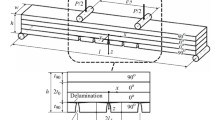Abstract
The development of damage in cross-ply Hercules AS4/3502 graphite/epoxy laminates has been investigated. Specific endeavors were to identify the mechanisms for initiation and growth of matrix cracks and to determine the effect of matrix cracking on the stiffness loss in cross-ply laminates. Two types of matrix cracks were identified. These include both straight and curved cracks. The experimental study of matrix crack damage revealed that the curved cracks formed after the straight cracks and followed a repeatable pattern of location and orientation relative to the straight cracks. Therefore, it was postulated that the growth mechanism for curved cracks is driven by the stress state resulting from the formation of the straight cracks. This phenomenon was analytically investigated by a finite-element model of straight cracks in a cross-ply laminate. The finite-element results provide supporting evidence for the postulated growth mechanism. The experimental study also revealed that the number of curved cracks increased with the number of consecutive 90-deg plies. Finally, experimental results show as much as 10-percent degradation in axial stiffness due to matrix cracking in cross-ply graphite/epoxy laminates.
Similar content being viewed by others
References
Aveston, J. andKelly, A., “Theory of Multiple Fracture of Fibrous Composites,”J. Mat. Sci.,8,255 (1973).
Garrett, K.W. andBailey, J.E., “Multiple Transverse Fracture in 90° Cross-ply Laminates of Glass Fiber-reinforced Polyester,”J. Mat. Sci.,12,157 (1977).
Stinchcomb, W.W., Reifsnider, K.L., Yeung, P. and Masters, J., “Effect of Ply Constraint on Fatigue Damage Development in Composite Material Laminates,” Fatigue of Fibrous Comp. Mat., ASTM STP 723, 65–84.
Wang, A.S.D. and Crossman, F.W., “Initiation and Growth of Transverse Cracks and Edge Delamination in Composite Laminates: Part I,” J. Comp. Mat., Supplemental Vol., 76 (1980).
Crossman, F.W., Warren, W.J., Wang, A.S.D. and Law, Jr., G.E., “Initiation and Growth of Transverse Cracks and Edge Delamination in Composite Laminates: Part 2. Experimental Correlation,” J. Comp. Mat., Supplemental Vol., 103 (1980).
Wang, A.S.D., “Growth Mechanisms of Transverse Cracks and Ply Delamination in Composite Laminates,” Proc. 3rd Int. Conf. on Comp. Mat., Paris, 170 (1980).
Crossman, F.W. and Wang, A.S.D., “The Dependence of Transverse Cracking and Delamination on Ply Thickness in Graphite/Epoxy Laminates,” ASTM STP 775, Damage in Composite Materials, ed. K.L. Reifsnider, Amer. Soc. Test. and Mat., 118 (1982).
Jamison, R.D. and Reifsnider, K.L., “Advanced Fatigue Damage Development in Graphite Epoxy Laminates,” AFWAL TR-82-3103 (Dec. 1982).
Reifsnider, K.L., Henneke, E.G., Stinchcomb, W.W. andDuke, J.C., “Damage Mechanics and NDE of Composite Laminates,”Mechanics of Composite Materials, ed. Z. Hashin andC.T. Herakovich, Pergamon Press, Oxford, 399–420 (1982).
Arenberg, R.T., “Analysis of the Effect of Matrix Degradation on Fatigue Behavior of a Graphite/Epoxy Laminate,” Thesis, Texas A&M Univ. (May 1982).
Talug, A., “Analysis of Stress Fields in Composite Laminates with Interior Cracks,” PhD Thesis, College of Engineering, Virginia Polytechnic Inst. and State Univ. (Sept. 1978).
Altus, E., Rotem, A. andShmveli, M., “Free Edge Effect in Angle Ply Laminates — A New Three Dimensional Finite Difference Solution,”J. Comp. Mat.,14,21–30 (Jan. 1980).
Reifsnider, K.L., “Some Fundamental Aspects of the Fatigue and Fracture Response of Composite Materials,” Proc. 14th Annual Soc. of Eng. Sci. Mtg., Lehigh Univ., 373–383 (1977).
O'Brien, T.K., “Characterization of Delamination Onset and Growth in a Composite Laminate,” Damage in Composite Materials, ASTM STP 775, ed. K.L. Reifsnider, Amer. Soc. for Test. and Mat., 140–167 (1982).
Badaliance, R. andSih, G.C., “An Approximate Three-Dimensional Theory of Layered Plates Containing Through Thickness Cracks”,Eng. Fract. Mech.,7,1–22 (1975).
Altus, E. andRotem, A., “A 3-D Fracture Mechanics Approach to the Strength of Composite Materials,”Eng. Fract. Mech.,14,637–644 (1982).
Chen, E.P. andSih, G.C., “Stress Intensity Factor for a Three-Layered Plate with a Crack in the Center Layer,”Eng. Fract. Mech.,14,195–214 (1982).
Schapery, R.A., “Correspondence Principles and a Generalized J-Integral for Deformation and Fracture Analysis of Nonlinear Viscoelastic Media,” Rep. MM-3724-80-16, Air Force Office of Scientific Research (Nov. 1980).
Wang, S.S. andChoi, I., “The Interface Crack Between Dissimilar Anisotropic Composite Materials”,J. Appl. Mech.,50,169–178 (1983).
Chou, P.C. and Wang, A.S.D., “Cumulative Damage Model for Advanced Composite Materials,” Interim Tech. Rep. No. 4, Contract No. F33615-80-C-5039, Air Force Wright Aero. Labs. (Feb. 1983).
Hahn, H.T. andKim, R.Y., “Proof Testing of Composite Materials,”J. Comp. Mat.,9,297–311 (July 1975).
Hashin, Z. and Rotem, A., “A Cumulative Damage Theory of Fatigue Failure,” AFOSR 76-3015, TAU-SOE/395-77 (Feb. 1977).
Talreja, R., “Fatigue of Composite Materials: Damage Mechanisms and Fatigue-Life Diagrams,”Proc. Roy. Soc. London,378A,461–475 (1981).
Talreja, R., “A Continuum Mechanics Characterization of Damage in Composite Materials”,Proc. Roy. Soc. London,399A,195–216 (1985).
Krajcinovic, D., “Constitutive Equations for Damaging Materials,” J. Appl. Mech., 355–360 (1983).
Dvorak, G.J., Laws, N. andHejazi, M., “Analysis of Progressive Matrix Cracking in Composite Laminates I. Thermo-elastic Properties of a Ply with Cracks,”J. Comp. Mat.,19,216–234 (1985).
Allen, D.H., Groves, S.E. and Harris, C.E., “A Thermomechanical Constitutive Theory for Elastic Composites with Distributed Damage, Part I: Theoretical Development,” Rep. MM-5023-85-17, Texas A&M Univ. (Oct. 1985).
Allen, D.H., Harris, C.E. and Groves, S.E., “A Thermomechanical Constitutive Theory for Elastic Composites with Distributed Damage, Part II: Application to Matrix Cracking in Laminated Composites,” Rep. MM-5023-85-15, Texas A&M Univ. (Oct. 1985).
Author information
Authors and Affiliations
Rights and permissions
About this article
Cite this article
Groves, S.E., Harris, C.E., Highsmith, A.L. et al. An experimental and analytical treatment of matrix cracking in cross-ply laminates. Experimental Mechanics 27, 73–79 (1987). https://doi.org/10.1007/BF02318867
Received:
Accepted:
Issue Date:
DOI: https://doi.org/10.1007/BF02318867




